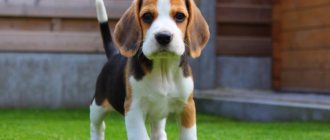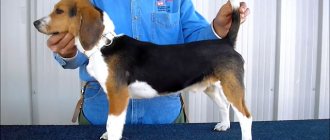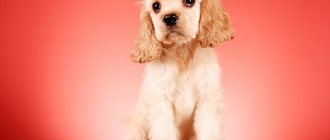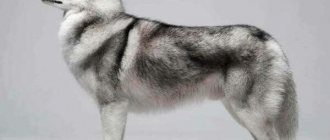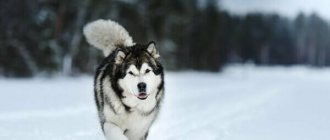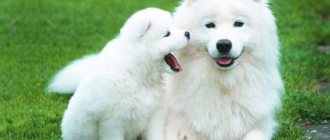In the Middle Ages, when English statehood and its aristocracy were emerging, hunting was entertainment.
Noble ladies took part in it, for whom small dogs were bred.
The small animal allowed you to control yourself; it was indispensable in hunting hares.
The dogs became the ancestors of the Beagle breed, active, sociable, intelligent dogs with a melodious bark, pleasant to the aristocratic ear.
Later, when beagles became available to everyone and the nobility lost interest in them, dogs were also used for hunting, due to their sociable nature, they were attracted to work in the fields.
Adult beagle sizes for boys and girls
A moving beagle gives the impression of a swimming dog due to its proportional build: level back, good chest and correct angles of the hind legs.
Back in 1988, the English Beagle Club approved the standards for this breed. The standards for purebred dogs were determined: weight, height, proportions, color.
According to the breed standard , the height at the withers of a beagle should be: for a male - 36-41 cm, for a female - 33-38 cm .
The body length is average, in males it reaches 45-47 cm, in females - 41-43 cm.
The sternum is wide, reaching an average girth of 62 cm in males and 60 cm in females.
Expert opinion
Kozhevin Semyon Kirillovich
Expert dog handler.
With the help of selection, two subspecies of Beagle hounds have been bred - American and English, where the first has greater muscle mass, weighs about eighteen kilograms, height at the withers - 42-43 cm, is longer by two to three centimeters, sometimes the body grows up to fifty centimeters. The skull is angular. The second one is inferior to the American by an order of magnitude and looks miniature.
How do I know if my beagle is overweight?
There are several ways to determine if your beagle is overweight. You can monitor their weight using a dog scale. Or you can do a visual assessment.
Looking from above, check if the ribs are sticking out, you can also feel the ribs under their fur, this should indicate the correct weight. Also check their spine, it is covered with a thin layer of skin. If you can easily feel it through their skin, then they are healthy.
If it's harder to find, then they're probably carrying a few extra pounds.
Their waist should also be defined and not sagging; if they have fat, it will be visible around the chest and at the base of the tail.
Beagles, being hounds, will run and exercise and this gives them strong muscles. This exercise should sharpen their body. If your puppy looks bulky and heavy, you need to put him on a diet right away.
Another easy way to tell if your beagle is carrying extra weight is if he struggles on walks.
If they begin to pant more often than usual or become less energetic, this may be a clear sign that they are overweight.
All dogs love to be groomed. If your beagle takes less care of himself and is having difficulties, this could also be a sign of weight gain.
Breed standard
Such superficial standards do not allow one to fully appreciate the hunting merits of the beagle.
For this, there are additional parameters to distinguish a high-class dog from an average one :
- The bones of the muzzle should be strictly parallel.
- The ears should reach the tip of the nose and be neither longer nor shorter.
- The neck is powerful, the loin is short.
- For the correct positioning of the heart and lungs, the chest must be wide enough.
- The body is long, the legs are not short, otherwise the dog looks like representatives of other breeds.
- The Beagle is an athlete and should not look overweight or fragile.
- The tail should be long and not curl.
- The back part should have developed muscles.
The presence of such parameters makes it possible to tirelessly run long distances, follow the trail and not get lost from sight, that is, exactly match the breed.
Characteristic
Beagle puppies (photo below) are small, brave and inquisitive explorers. With a bright temperament and good health, a true beagle should not be cowardly, angry or lethargic.
Beagle puppies captivate with their charming appearance and endless love for the world around them. They love children, toys and outdoor games. They are distinguished by their intelligence, know how to be cunning and attract attention.
By nature, little beagles are real optimists and fidgets who will not let you get bored. The Beagle is curious, playful and persistent. He can tirelessly run after the ball, poke his nose into everything, jump and gallop, while bursting into loud barks.
The beagle puppy radiates happiness and positivity; despondency and boredom are unknown to him. He will become a companion for active people with a sense of humor, but he will quickly tire of homebodies and childish individuals.
How old do they grow and how long do they live?
The length of time a dog grows depends on its breed and body structure. Large ones stop growing at 9 months, small ones a little earlier.
When a Beagle cub doubles its weight, which occurs at six months of age, long bone growth virtually stops..
This means that the individual has almost reached its height in length and will gain weight, growing in width.
In girls, growth stops with the first heat. Males continue to grow a little longer, but growth does not stop at puberty.
Dental care
Milk teeth appear in beagles by 1 month, and at the age of 3-4 months they begin to be replaced by molars. This process lasts up to six months, sometimes longer.
During this period, the dog needs toys that it can chew on, as well as various hard treats.
The change of teeth should be monitored and if abnormal growth of molars, wounds or swelling in the pet’s mouth is detected, it is necessary to show it to a veterinarian.
To avoid problems with teeth and gums, you need to brush your dog's teeth weekly with a special soft toothbrush and toothpaste. To brush a beagle's teeth, you need to open its mouth slightly with one hand and brush from the base of the tooth to the edge.
Weight of an adult dog - boy and girl
A distinctive feature of the Beagle is its omnivorous nature and the inability to stop while eating..
In this regard, excess weight is observed if the dog moves little or is fed more than 2 times a day.
The average weight of a male is 10-11 kg, some individuals reach 16-18 kg, which is also considered the norm, if the dog is active and mobile, its body maintains its proportions.
The average weight of a female is 9-11 kg, sometimes 14-17 kg, which is acceptable under the same conditions as for a boy.
Maximum parameters
Cynologists distinguish three subspecies of the breed: European (English), American and French. The latter option did not take root in the Russian Federation. “American”, compared to his relatives, is greater than others in all respects:
- Beagle height - up to 41 cm;
- weight - 18 kg.
The American variety has an angular head type, while the European variety has a rounded head.
Important! How much does an adult female beagle weigh: from 14 to 17 kg. Large individuals must maintain proportions; the ideal appearance is achieved under conditions of normal development, sufficient physical and motor activity.
Dimensions difference
Puppy weight and size by month from 1 to 12 months
During the first year of life, a beagle puppy should acquire the weight and proportions of an adult dog; a girl's developmental indicators will be slightly lower. The difference in weight by gender begins to be determined at one and a half to two months. By this time, the puppies are a small copy of their parents.
In the period from three to six months, the weight of the cubs doubles and the chest and paws intensively develop.
In the period from six to twelve months, the puppy turns into a full-fledged representative of its breed.
The table shows approximate indicators of weight gain and height during the first year of life.
Since each individual is individual, slight discrepancies in numbers are possible.
| Age | Weight | Height | ||
| Male | Bitch | Male | Bitch | |
| At birth | 300 g | 450 g | — | — |
| 1 month | 1.5 kg | 2 kg | 18 cm | 20 cm |
| 2 months | 3-4 kg | 3-4 kg | 22 cm | 25 cm |
| 3 months | 5 kg | 6 kg | 28 cm | 30 cm |
| 4 months | 6-7 kg | 7-8 kg | 30 cm | 32 cm |
| 5 months | 7-8 kg | 8-10 kg | 32 cm | 34 cm |
| 6 months | 8-9 kg | 10-12 kg | 33 cm | 35 cm |
| 7 months | 9-10 kg | 12-13 kg | 35 cm | 37 cm |
| 8 months | 9.5-10.5 kg | 13-14 kg | 35.4 cm | 37.3 cm |
| 9 months | 10.8 kg | 14-15 kg | 35.6 cm | 37.5 cm |
| 10 months | 11-12 kg | 15-16 kg | 36 cm | 38 cm |
| 11 months | 12-13 kg | 16-17 kg | 37 cm | 39 cm |
| 12 months | 13-14 kg | 17-18 kg | 38 cm | 40 cm |
First vaccinations
Newborn puppies are protected by immunity received from their mother. This protection operates during the feeding period, but at the end of lactation it gradually weakens, replaced by the puppies’ own immunity.
To form an active immune system and protect against infections and viral diseases, vaccination is required in accordance with the basic rules:
- the dog must be absolutely healthy, otherwise there is a risk of death;
- You cannot vaccinate a pregnant or lactating bitch;
- 7-10 days before vaccination, the dog must be treated for parasites (worms, fleas, ticks).
The vaccination schedule includes vaccinations against:
- plague (D);
- hepatitis (H);
- adenovirus infection (A);
- parainfluenza (Pi);
- leptospirosis (L);
- parvo and coronavirus enteritis (P);
- rabies (R).
The drug is chosen by the dog owner. Vaccines of the Eurikan or Nobivak brands have proven themselves well.
There are several vaccination schedules:
| Scheme | Schedule and vaccine |
| Scheme 1 |
|
| Scheme 2 |
|
| Scheme 3 |
|
After the last vaccination, you must undergo a two-week quarantine; only after this the puppy can be taken outside.
In the future, vaccination should be carried out annually. In the case of using schemes 1 and 2, with the drug Nobivak DHPPI+LR, with scheme 3 - Eurikan DHPPI2+LR.
IMPORTANT!
Vaccination and revaccination are carried out using the same drug.
What influences development?
The correct development of any puppy is evidenced by the presence of forty-two permanent teeth by seven months.
If the enamel is fragile, teeth grow slowly - this is a sign of a lack of vitamins A and D, mineral salts, especially phosphorus and calcium in the diet. The presence of helminths also does not contribute to gaining sufficient weight.
NOTE!
A puppy, and even an adult dog, will stop gaining weight, growing and existing if they are pampered with chocolate, smoked meats, sweets, fatty and sweet foods.
An apple, carrot, and a small piece of hard cheese are allowed as treats.
Good living conditions for dogs, sufficient room temperature, access to fresh air, affectionate treatment are the conditions for the proper development of puppies .
What to feed for the first 3 months?
During the first month, puppies eat only mother's milk, then complementary foods are gradually introduced.
If we are talking about dry food, then it should be at least premium class, preferably super-premium or holistic, and intended specifically for puppies. Before giving your pet food, it needs to be soaked in milk or broth.
With natural feeding, it is necessary that 70% of the diet consists of boiled lean meat, and the remaining 30% - cereals, milk, and vegetables.
NOTE!
With a natural diet, it is necessary to give beagles additional vitamins and minerals.
After 2 months, the diet should include:
- cottage cheese;
- cereals - oatmeal, buckwheat, semolina;
- kefir;
- boiled eggs;
- boiled vegetables;
- greenery.
At 3 months you can give puppies some sea fish and raw vegetables.
What to do if it lags behind the norm
The correct conditions of intrauterine life and the first six months ensure the good development of the newborn beagle. First of all, this is timely feeding with balanced food.
In the first month, when the pups are fed with mother's milk, underweight puppies should be applied to the rear, fuller nipples.
If you left more than six individuals in the litter, you should take care of artificial feeding.
Infant formulas are prohibited for feeding due to the sugar in their composition. You must adhere to the diet prepared by your veterinarian.
After weaning from the mother, you can feed both natural food (the diet is prepared by a specialist) and factory-made balanced premium food..
To do this, buy food marked “For puppies.” This food is preferable, since it contains all the necessary micro- and macroelements and is not contaminated with helminths.
Those who have chosen natural feeding need to remember the freshness and quality of the products and the presence of vegetables and fruits with coarse fiber in the diet, and also adhere to the norm of vitamins and mineral salts.
For one kilogram of puppy weight it is required:
- 9 g protein;
- 2.5 g fat;
- 14 g sugar and starch;
- 1.5 g fiber;
- 500 mg calcium;
- vitamins A, D and E.
With any choice of food, the dog must be provided with a sufficient amount of fresh water. Otherwise, the digestive process will be disrupted, difficulties with bowel movements will arise, and growth and weight gain will slow down.
For proper weight gain by a puppy, the following frequency should be observed::
- 2-3 months feed six times a day;
- 4 month - four times;
- 5 month - three times;
- 6 month - morning and evening.
If puppies grow rapidly according to norms, this indicates proper bone growth. That is, no mistakes are made when feeding.
IMPORTANT!
It must be remembered that excess weight is also harmful for young animals, since it is an extra load on the fragile skeletal system.
Therefore, it is imperative to adhere to the norm.
Colors
This breed has many color options; in general, they are all divided into bicolor and tricolor. Primary colors:
- white;
- ginger;
- black.
There are also three color options :
- spotted;
- mottled;
- motley.
Attention! For Beagles, a solid brown (liver) color is unacceptable, as it is often accompanied by light yellow and green eyes, which is considered a defect. But the American breed standard allows this shade in the tricolor.
Tricolor
The classic beagle color is tricolor. There are many options for this color. The tricolor consists of large spots and can be either black (with a predominance of black) or “shiny” or “flashing” (with a predominance of white).
The red color may appear as the puppy grows and gain different intensities (from lemon or cream to rich copper and red), the black color may fade a little, and the white color may turn into cream.
Quite rare is a weakened tricolor, in which black is replaced by gray or blue. These puppies are born gray and white.
Bicolor
Bicolor is characterized by a combination of white and red in color, extremely rarely - white and black. There is also a known color variant called “lemon”: this puppy is born white with barely noticeable cream spots, which become more intense and distinct as the year progresses.
Spotted
This color is also called open or broken tricolor. The main color of the coat is white, with dark spots scattered throughout it, sometimes interspersed with red.
Speckled (speckled)
This color is found in both two-color and three-color versions, and it is difficult to confuse it with others, thanks to the large number of small spots scattered throughout the body singly and in clusters. A speck on a pure white background, without spots of a different color, is considered a flaw.
Help: The speckled color is genetically determined only in puppies with dark pads on their paws, this becomes clear at birth. The color itself appears by two months.
Motley
This is the most unusual type of color. Only white coat color is represented in its entirety, while red and black are mixed. In this case, the white background always has a purple or cream tint. Variegated color can be either continuous or fragmented. The nose with this color is dark with a light center.
There are three varieties of variegated color:
- lemon-variegated (with a predominance of cream hairs);
- hare-motley (mainly with red tones of color);
- badger-variegated (main hairs are black).
In all three cases, a red mask on the face is required.
The last option is the rarest and brightest; with this color, the dog’s nose is edged with a dark outline.
Note: Solid white coat color is also allowed (the only monocolor option).
Basic moments
- The Beagle constantly needs company and therefore does not tolerate loneliness well.
- Representatives of the breed are endowed with quick wit and flexible intelligence - and all this combined with stubbornness.
- The dog is always energetic and cheerful, loves to run and frolic in the fresh air.
- The main problem with beagles is their loud barking, so be prepared for possible disputes with your neighbors.
- Animals gain weight easily, so they need regular exercise and proper feeding.
- Dogs are friendly even with strangers and therefore are not always good guards.
- The Beagle gets along well with children and becomes a devoted friend to them.
- It is not recommended to keep a beagle in the same apartment as cats or small ornamental animals.
- Not suitable for beginner dog owners due to its independent nature.
The Beagle instantly captivates with its remarkable charm. A dog's hazel eyes look straight into your soul, especially if the animal intends to beg you for a tasty morsel. The charming appearance of the fidget is in perfect harmony with his character, so you should not expect meekness and calmness from the beagle. Despite its moderately short legs, the dog can develop high speed when chasing a pigeon or a neighbor's cat. Beagles are very active by nature. For this breed, there is no better entertainment than a walk in the city park. Bring a frisbee or tennis ball with you and your dog will be happy.
How to choose your future pet?
If you decide to choose a beagle puppy, first of all you need to pay attention to its physical condition.
In a healthy beagle:
- shiny thick coat evenly covering the body, no bald patches or dandruff;
- scissor bite;
- the nose is moist and cold, pigmented black, without discharge;
- the mucous membranes of the mouth are pale pink;
- the paws are strong, there are small seals in the area of the knee joints, there are no dewclaws;
- the eyes are shiny, the ears are clean, there is no discharge or odor;
- The male has 2 developed testicles, no signs of cryptorchidism.
The puppy must move confidently and be active, curious, and cheerful.
In males, stubbornness and independence are more pronounced - a boy is usually more difficult to educate and train, and is inclined to run after prey and a female in heat.
Bitches are more affectionate and obedient; training girls is much easier. Among their disadvantages are regular estrus, when they become the object of hunting by males. Also at this time they may experience changes in behavior.
NOTE!
If a dog is purchased for hunting, then there is no difference between a male and a female - the hunting instinct is equally developed in both sexes.
It is better to purchase a puppy from a specialized nursery after learning about the conditions of their care and the health status of the parents.
In case of purchasing a purebred representative of the breed, the breeder is obliged to present all the necessary documents:
- pedigree;
- birth certificate;
- veterinary passport;
- inspection report;
- application for registration in the club.
